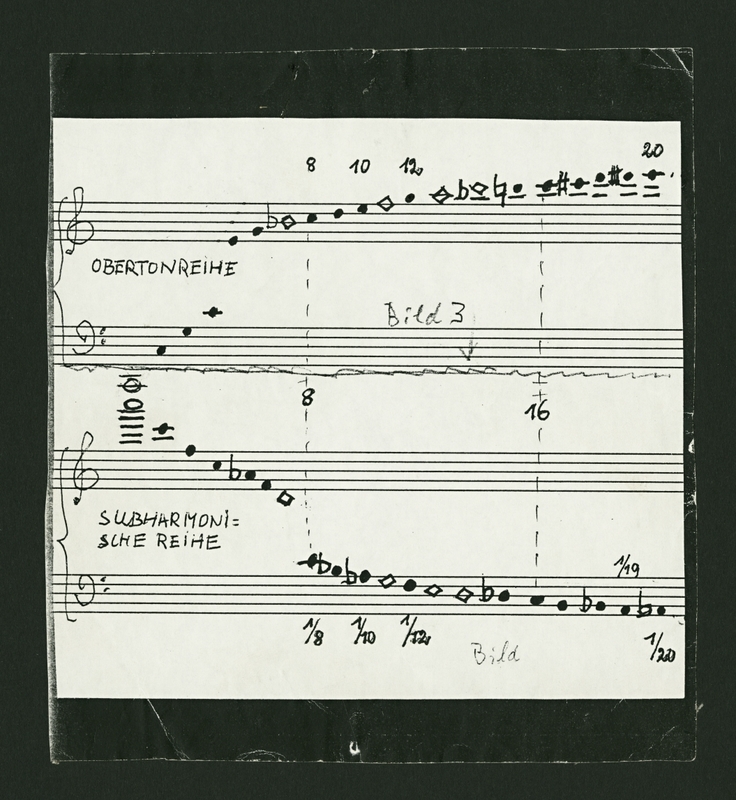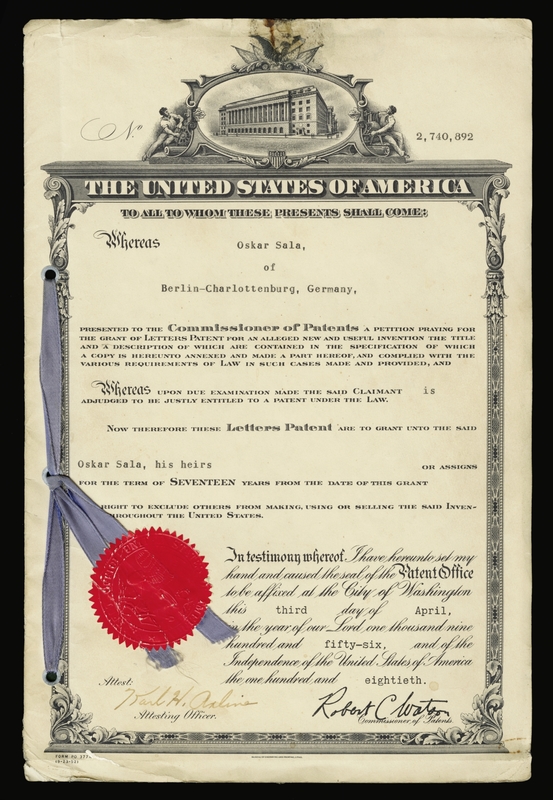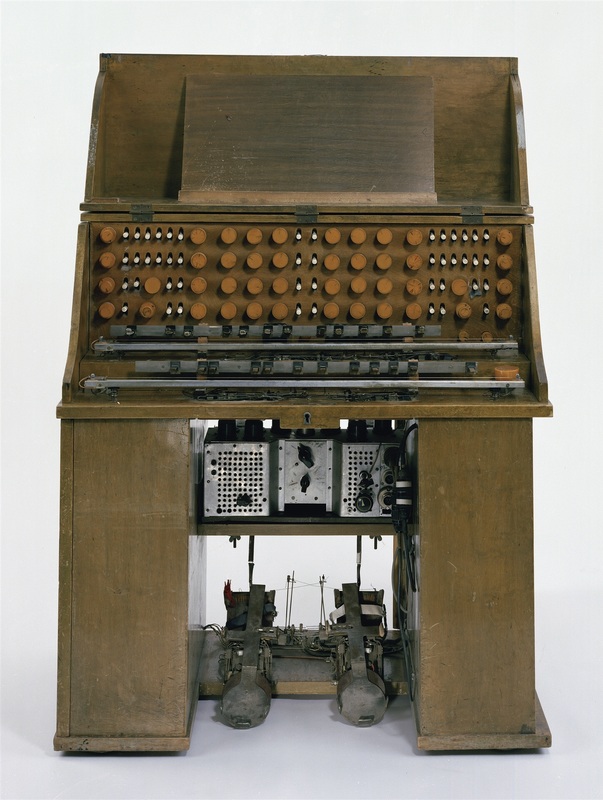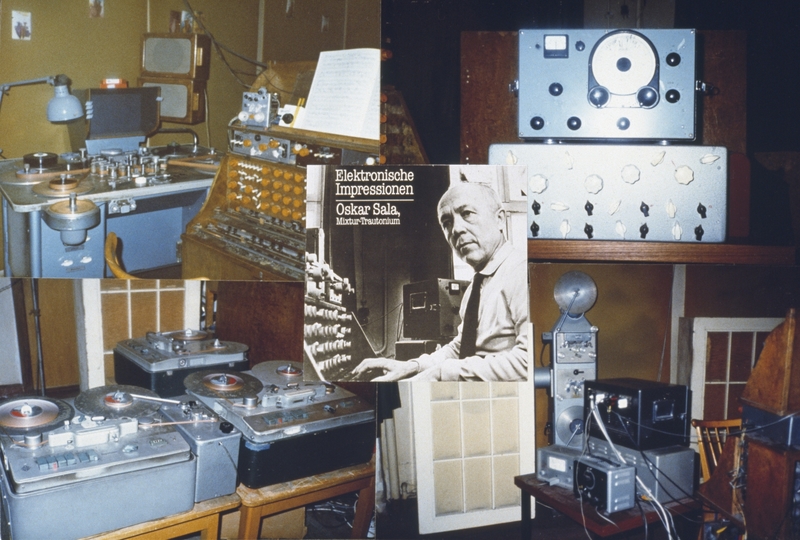From stage to screen
The Trautonium in the studio
After World War II, Sala’s pursuit of ever-increasing virtuosity led him to bring the Trautonium to its final evolutionary stage. In 1952, Sala completed the construction of the Mixturtrautonium, in which up to four subharmonic frequencies could be generated from the fundamental frequency on each of the two playing manuals respectively.
Unlike the mixtures of a pipe organ, these notes were not derived from the overtone series, but rather the subharmonic series, that is the inversion of the overtone spectra below the fundamental. Sala successfully developed and patented a synchronizing circuit that enabled the simultaneous generation of up to four subharmonic frequencies at distinct whole-number ratios to the main tone frequency.[14]
The Mixturtrautonium’s construction could accommodate up to four auxiliary circuits per manual; each auxiliary circuit in turn consisted of three adjustable subharmonic settings. For each manual, the desired setting could be accessed via moving the pedals laterally across the settings labelled h, m and t respectively. While this could be viewed as a measure to overcome the limitations of Trautonium’s monophonic playing manuals to a certain extent, independent polyphonic voices on a single manual was still not possible.
Notwithstanding the lingering limitations of the manual’s design, the subharmonic configuration of the Mixturtrautonium furnished Sala with the means necessary for him to develop a unique aesthetic that distinguished his works. When a setting which activated the maximum of four pitches was selected, a dense texture of chords progressing in parallel was produced. However, as Sala noted, the “mixtures” (“Mixturen”) were by no means a sum of equal notes, although they may appear so in the score. More often than not, they consisted of a “leading note” (“Führungston”) and a “chordal framework” (“Akkordgerüst”), which is built upon a combination of subharmonic notes, whose volumes could be adjusted individually.[15]
In 1958, Sala established the Mixturtrautonium as the heart of his personal studio in Berlin.[16] His set-up included the auxiliary equipment he termed “electronic percussion”: an “electric metronome” (a circuit breaker), a “decay device” (an envelope generator) und a “noise generator,” which served to modify the sounds produced by the Mixturtrautonium.[17] This auxiliary equipment greatly increased the versatility of the Mixturtrautonium not only in purely instrumental works but also in audio-visual media. When coupled with tape techniques, the outer-limits of the Mixturtrautonium could be further transcended. His vinyl album Electronic Virtuosity (1970) contained his first electronic compositions for Mixturtrautonium and “studio techniques.”
Concertando. Second movement of Oskar Sala’s Resonances. Concerto for Mixture-Trautonium and Electronic Orchestra. [Fugato - Concertando - Ostinato].
Featured in Oskar Sala: Electronic Virtuosity
Original: LP, Selected Sound, 1970.
Sala also fitted his studio with a cutting-edge Steenbeck 6-plate editing table and a “Perfomaschine” (a tape machine for perforated tapes), which permitted exact sound-image synchronization and subsequent high fidelity sound reproduction. Sala self-acquired the skills to operate his high-tech equipment – his personal dedication paying off in the discovery of editing techniques which yielded unprecedented results in his electronic music: “possibilities that one would never have dared attempt with non-electronic music.”[18]
Sala lent the Mixturtrautonium’s idiomatic sound to film and television, especially in the cultural and industrial films of the 1950s and 60s. Particularly noteworthy achievements include his work for the industrial film Stahl, Thema mit Variationen (1960) by Hugo Niebeling, which was awarded the Grand Prix at the Industrial Film Festival in Rouen in 1961 and the short film A fleur d’eau (1962) by Alexander Seiler and Rob Gnant, which won one of the two Grand Prix awarded to short films in Cannes in 1963. The avian sounds he produced for Alfred Hitchcock’s film The Birds (1963) remains his most famous work internationally.
The Oskar-Sala-Fonds website (http://www.oskar-sala.de/oskar-sala-fonds/klaenge/) contains several sound clips of Sala’s work from his original tapes, including excerpts from Hitchcock’s The Birds, Willy Zielke’s short documentary film Aluminium. Porträt eines Metalls (1957/58) and Manfred Durniok’s film Unterwegs nach Kathmandu (1971) amongst others.
[14] Sala expounds the features of the Mixturtrautonium in Oskar Sala, ‘Das Mixtur-Trautonium’, in: Melos 17 (1950), pp. 247–251, in particular pp. 249–251; and later in greater detail in Oskar Sala, ‘Subharmonische elektrische Klangsynthesen‘, in: Fritz Winkel (ed.), Klangstruktur der Musik. Neue Erkenntnisse Musik-Elektronischer Forschung. Berlin 1955, pp. 89–108, in particular pp. 89–95.
[15] Oskar Sala, ‘Das Mixtur-Trautonium’, in: Melos 17 (1950), pp. 247–251, here p. 250.
[16] The new permanent exhibition for musical instruments at the Deutsches Museum, Munich will feature a reconstruction of parts of Sala’s studio. For more information see Christina Dörfling, ‘Reconstructing a Studio: Oskar Sala’s Nachlass at the Deutsches Museum, Munich’, Sound & Science: Digital Histories, Max Planck Institute for the History of Science, https://acoustics.mpiwg-berlin.mpg.de/contributor-essays/reconstructing-studio-oskar-salas-nachlass-deutsches-museum-munich
[17] For more detailed information, see Oskar Sala, ‘Subharmonische elektrische Klangsynthesen‘, in: Fritz Winkel (ed.), Klangstruktur der Musik. Neue Erkenntnisse Musik-Elektronischer Forschung. Berlin 1955, pp. 89–108, in particular pp. 99–101. For the English terms used to designate Sala’s devices, please refer to Davies, Hugh, and Peter Donhauser. "Mixtur-Trautonium." Grove Music Online. January 20, 2016. Oxford University Press. Date of access 29 Apr. 2020, https://www-1oxfordmusiconline-1com-10012c1m409b4.emedia1.bsb-muenchen.de/grovemusic/view/10.1093/gmo/9781561592630.001.0001/omo-9781561592630-e-4002291192
[18] Peter Badge, Oskar Sala. Pionier der elektronischen Musik, Göttingen 2000, [unpaginated]. The English translation of Sala’s comment is provided by Hughes Casement and Gérard A. Goodrow.
Citation: Julin Lee, ‘Subharmonic Fantasias: The Legacy of Oskar Sala and the Mixturtrautonium’, in: Materiality of Musical Instruments. A Virtual Exhibition.




